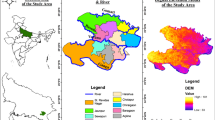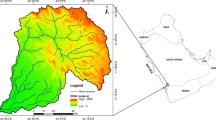Abstract
Regional scale modeling of coupled groundwater-surface water interaction in canal command areas is difficult due to high computational requirements and data insufficiency. Groundwater plays an essential role in the interaction process to fulfil the irrigation requirement in tail reaches of canal command areas. A comprehensive coupled model is required to simulate the canal command systems by incorporating the processes: (a) saturated groundwater flow, (b) unsaturated flow and (c) overland flow. In the present work, a fully-coupled model is developed that simulates saturated groundwater flow using Analytic Element Method (AEM), unsaturated flow using analytical solution and overland flow using Finite Volume Method (FVM) based Zero-inertia model. The Capability of the developed coupled model is demonstrated for Damodar Left Bank Main Canal (LBMC) under two canal regulation scenarios for “Boro Rice” cultivation season (Jan-Apr). Major canal water shortage is observed in LBMC during this season. It can be observed from the results that hydraulic heads in the upper reach are quite high whereas it is significantly lowering down as we move away from the main canal or in the lower reach where the groundwater is the main source of Boro rice irrigation. The considerable decline in hydraulic head values can be observed in LBMC which can be justified with a decrease in water supply and an increase in the area under Boro rice cultivation.







Similar content being viewed by others
Data Availability
All data that support the findings are available from the corresponding author upon reasonable request.
References
Ahmad I, Zhang F (2022) Optimal agricultural water allocation for the sustainable development of surface and groundwater resources. Water Resour Manage 36(11):4219–4236
Aricò C, Nasello C (2018) Comparative analyses between the zero-inertia and fully dynamic models of the shallow water equations for unsteady overland flow propagation. Water 10(1):44
Bakker M (2007) Simulating groundwater flow to surface water features with leaky beds using analytic elements. Adv Water Resour 30(3):399–407
Bakker M, Anderson E, Olsthoorn T, Strack O (1999) Regional groundwater modeling of the yucca mountain site using analytic elements. J Hydrol 226(3):167–178
Bandilla K, Janković I, Rabideau A (2007) A new algorithm for analytic element modeling of large-scale groundwater flow. Adv Water Resour 30(3):446–454
Biswas P, Dhar A, Sen D (2017) A numerical simulation model for conjunctive water use in basin irrigated canal command areas. Water Resour Manage 31(12):3993–4005
Brufau P, García-Navarro P, Playán E, Zapata N (2002) Numerical modeling of basin irrigation with an upwind scheme. J Irrig Drain Eng 128(4):212–223
Caviedes-Voullième D, Fernández-Pato J, Hinz C (2020) Performance assessment of 2d zero-inertia and shallow water models for simulating rainfall-runoff processes. J Hydrol 584
Cea L, Garrido M, Puertas J (2010) Experimental validation of two-dimensional depth-averaged models for forecasting rainfall-runoff from precipitation data in urban areas. J Hydrol 382(1–4):88–102
Craig J, Janković I, Barnes R (2006) The nested superblock approach for regional-scale analytic element models. Groundwater 44(1):76–80
De Lange W (1999) A cauchy boundary condition for the lumped interaction between an arbitrary number of surface waters and a regional aquifer. J Hydrol 226(3):250–261
De Lange W (2006) Historical note: Development of an analytic element ground water model of the netherlands. Groundwater 44(1):111–115
Fitts C (1989) Simple analytic functions for modeling three-dimensional flow in layered aquifers. Water Resour Res 25(5):943–948
Geuzaine C, Remacle J (2009) Gmsh: A 3-d finite element mesh generator with built-in pre-and post-processing facilities. Int J Numer Meth Eng 79(11):1309–1331
Hunter N, Horritt M, Bates P, Wilson M, Werner M (2005) An adaptive time step solution for raster-based storage cell modelling of floodplain inundation. Adv Water Resour 28(9):975–991
Jha M, Singh L, Nayak G, Chowdary V (2020) Optimization modeling for conjunctive use planning in upper damodar river basin, india. J Clean Prod 273
Kebede S, Charles K, Godfrey S, MacDonald A, Taylor RG (2021) Regional-scale interactions between groundwater and surface water under changing aridity: evidence from the river awash basin, ethiopia. Hydrol Sci J 66(3):450–463
Kumari K, Dhar A (2020) Groundwater management using coupled analytic element based transient groundwater flow and optimization model. Algorithms and Applications in Science and Engineering, Nature-Inspired Methods for Metaheuristics Optimization, pp 119–134
Maheswaran R, Khosa R, Gosain A, Lahari S, Sinha S, Chahar B, Dhanya C (2016) Regional scale groundwater modelling study for ganga river basin. J Hydrol 541:727–741
Murillo J, García-Navarro P (2010) Weak solutions for partial differential equations with source terms: Application to the shallow water equations. J Comput Phys 229(11):4327–4368
Murray-Rust DH, Vander Velde EJ (1994) Conjunctive use of canal and groundwater in punjab, pakistan: management and policy options. Irrig Drain Syst 8(4):201–231
Omar PJ, Gaur S, Dwivedi S, Dikshit P (2019) Groundwater modelling using an analytic element method and finite difference method: an insight into lower ganga river basin. J Earth Syst Sci 128:1–10
Philipp A, Liedl R, Wöhling T (2012) Analytical model of surface flow on hillslopes based on the zero inertia equations. J Hydraul Eng 138(5):391–399
Playán E, Walker W, Merkley G (1994) Two-dimensional simulation of basin irrigation. ii: Applications. J Irrig Drain Eng 120(5):857–870
Pradhan S, Dhar A, Tiwari KN (2022a) On quantification of groundwater dynamics under long-term land use land cover transition. Water Resour Manage 36(11):4039–4055
Pradhan S, Dhar A, Tiwari KN, Sahoo S (2022b) Spatiotemporal analysis of land use land cover and future simulation for agricultural sustainability in a sub-tropical region of India. Environ Dev Sustain pp. 1–30
Rawls WJ, Brakensiek DL, Miller N (1983) Green-ampt infiltration parameters from soils data. J Hydraul Eng 109(1):62–70
Schmitz G, Seus G (1992) Mathematical zero-inertia modeling of surface irrigation: Advance in furrows. J Irrig Drain Eng 118(1):1–18
Strack O (1989) Groundwater mechanics. Prentice Hall, Eaglewood Cliff, New Jersey
Strack O (2003) Theory and applications of the analytic element method. Rev Geophys 41(2)
Strack O (2006) The development of new analytic elements for transient flow and multiaquifer flow. Groundwater 44(1):91–98
Tong C, Wang C, Xiong M, Huang CS, Yeh HD (2023) An analytical and meshless model for 3d transient flow in a confined aquifer with nonuniform thickness: Application to stream depletion due to groundwater extraction. Environ Model Software 159
Valipour M (2012) Comparison of surface irrigation simulation models: full hydrodynamic, zero inertia, kinematic wave. J Agric Sci 4(12):68
Zapata N, Playan E (2000) Simulating elevation and infiltration in level-basin irrigation. J Irrig Drain Eng 126(2):78–84
Zhang S, Xu D, Bai M, Li Y, Xia Q (2014) Two-dimensional zero-inertia model of surface water flow for basin irrigation based on the standard scalar parabolic type. Irrig Sci 32(4):267–281
Zhang S, Bai M, Xia Q, Yu H (2017) Efficient simulation of surface water flow in 2d basin irrigation using zero-inertia equations. J Irrig Drain Eng 143(1):04016069
Zhao J, Liang Q (2022) Novel variable reconstruction and friction term discretisation schemes for hydrodynamic modelling of overland flow and surface water flooding. Adv Water Resour 163
Funding
This work is partially supported by the Ministry of Water Resources, River Development & Ganga Rejuvenation, Government of India (Ref.: 21/117/2012-R &D/393-404).
Author information
Authors and Affiliations
Contributions
Komal Kumari: Conceptualization, Methodology, Validation, Writing - original draft. Anirban Dhar: Supervision, Writing - review and editing.
Corresponding author
Ethics declarations
Ethics Approval
Not applicable.
Consent to Participate
The authors declare their consent to participate in this work.
Consent for Publication
The authors have approved the manuscript and its submission to the Journal.
Conflicts of Interest
The authors declare that they have no conflict of interest.
Additional information
Publisher's Note
Springer Nature remains neutral with regard to jurisdictional claims in published maps and institutional affiliations.
Supplementary Information
Below is the link to the electronic supplementary material.
Rights and permissions
Springer Nature or its licensor (e.g. a society or other partner) holds exclusive rights to this article under a publishing agreement with the author(s) or other rightsholder(s); author self-archiving of the accepted manuscript version of this article is solely governed by the terms of such publishing agreement and applicable law.
About this article
Cite this article
Kumari, K., Dhar, A. Analytic Element-Finite Volume Based Coupled Groundwater-Surface Water Interaction model for Canal Command Systems. Water Resour Manage 37, 3151–3167 (2023). https://doi.org/10.1007/s11269-023-03494-0
Received:
Accepted:
Published:
Issue Date:
DOI: https://doi.org/10.1007/s11269-023-03494-0




